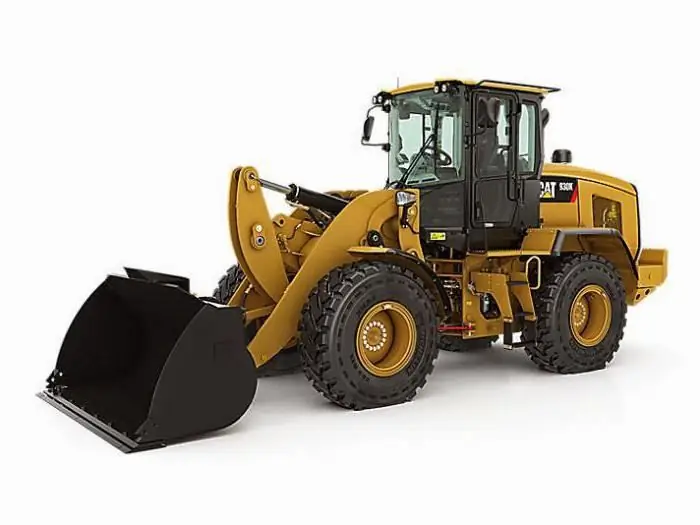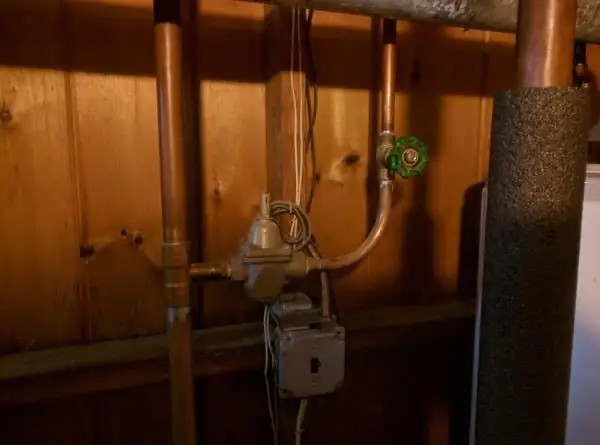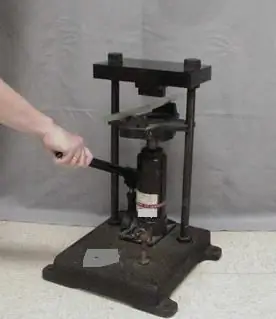2026 Author: Howard Calhoun | [email protected]. Last modified: 2025-01-24 13:10:29
Processing various materials under strong physical pressure allows you to perform stamping, cutting, straightening and other operations. Similar works are organized in construction, in production, in the transport sector and car services. Technical conditions for them are most often created by means of a hydraulic press, which is controlled directly by the operator without power auxiliary units.
General information about the machine
Pressing equipment has long been used by mankind as a simple and at the same time effective tool for exerting force on a workpiece. As the concept of piston mechanisms developed, more and more complex variations of equipment appeared and today you can find technological pneumohydraulic and electrohydraulic modifications on the market. They work through an additional power plant and do not require direct human participation in this process. What is the benefit of vertical lines against this background?hydraulic presses powered by physical force? First of all, they have a lower cost and complete independence from third-party power supply and drive mechanisms. The unit is completely autonomous and requires only periodic maintenance with an oil change.
Press design

It should be emphasized right away that different types of models are being produced today, both in structural and functional terms. For example, a desktop hydraulic press can be installed on a stationary workbench and perform small-format straightening of automotive parts. Classical vertical installations are used in the production of in-line stamping of various products and blanks. That is, at least this equipment can have different sizes.
But, regardless of the form factor, any press of this type is based on a high-strength column bed with a reliable platform. Functional nodes and auxiliary parts are fixed on this base. A typical hydraulic press device provides for the presence of two cylinders with different diameters, which communicate with each other. Their niches are filled with a special fluid that does not affect the metal of the structure, but at the same time performs the task of maintaining pressure.
Operation principle
The units work on the principles of hydrostatics. In particular, there is a law according to which the pressure exerted on a gas or liquid at rest will be uniformly transmitted in all directions associated with these media. This means that when pressure is applied to one of thethe aforementioned cylinders, the fluid in the second will lift the rod or piston. At the same time, due to the difference between the volumes of the cylinders, it is possible to obtain an additional force of the hydraulic press, which is involved in exerting pressure already on the workpiece. That is, if earlier this mechanism was used as a means of lifting, then as the technology developed, the opposite effect was also mastered, which is successfully used today in metal processing. Engineers gradually moved from workpiece deformation operations to mechanical cutting, chopping, etc.
Specifications

So that the unit does not disappoint during operation with its parameters and capabilities, you should familiarize yourself in advance with what characteristics such equipment is evaluated in principle. It’s worth starting with the maximum effort, which is expressed in tons. This is the amount of load exerted by the piston on the workpiece. The average force of a hydraulic press is 20 tons, and the extreme values can be represented in the range from 5 to 50 tons.
In domestic conditions for a garage or a small locksmith shop, it is quite possible to limit the load to 10 tons. In large industries that work with solid materials, the required power potential can be more than 50 tons. By the way, heat-treated parts are serviced by machines with a force of 65 tons. In order not to make a mistake in choosing the load for a particular workpiece, you should refer to pressure gauges - these are devices built into the design of the presses that show the currentoperating pressure.
The working stroke is also a significant technical and operational parameter. This characteristic of the hydraulic press determines the maximum dimensions of parts available for processing and on average varies from 110 to 235 mm. From the point of view of the convenience of handling blanks, it would be useful to think over the design features in advance. For example, which unit is better suited - floor or desktop. And also to evaluate the lift height of the press, which also sometimes acts as a limiter for loading large-format blanks.
Preparing the press for work

Before performing technical operations, you should familiarize yourself in detail with the parameters of a particular unit, which will minimize the risk of breakdown. Next, the following units and parts are checked:
- Fixing connections. All nuts, brackets and screws are tightened. Particular attention is paid to the handle, which directly directs the force to the machine. It is important to consider that the operation of a hydraulic press is accompanied by high loads and vibrations. If the design initially has a weak point, then during operation it will loosen even more, which can lead to breakage or injury.
- The free play of all movable parts of the unit is estimated. If necessary, change the water or technical oil in the cylinders. For example, it is recommended to lubricate press columns and plunger mechanisms with grease every shift.
- Valve stems and plug seals are inspected for physicaldefects. In order to eliminate possible fluid leaks in a timely manner, these parts should be checked before and after work.
Technical Fluid Tips

There is nothing difficult in the operation of updating water and oil in hydraulic equipment, but there are tricks that will help save on this consumable. For example, the performance characteristics of the oil in the form of heat resistance, adhesion and viscosity will last longer if the liquid is protected from fine dust, litter and dirt during the entire period of storage and direct use. It is also recommended to protect the composition from direct sunlight and air ingress.
The loss of working properties will be indicated by the darkening of the liquid, the formation of slags and organic acids in the composition. Again, maintaining performance is important primarily for the hydraulic press itself, its design surfaces that have direct contact with technical oil and water filler.
If the oil is clogged, then do not rush with a complete replacement. You can clean it with special filters. In metalwork workshops and in production, membrane devices made of perforated tin are used for these purposes. The wire and fabric layers of the filter will also get rid of small contaminants.
Troubleshooting

Uncharacteristic knocks, excessive vibrations will indicate the presence of breakdownsor insufficient force when lowering the valve. Among the reasons for the incorrect operation of the unit may be airing in the cylinders, incorrect adjustment of the design, errors when replacing valves and rods, as well as jamming of individual functional parts. In each case, there will be a sequence of actions aimed at restoring the equipment to working capacity, and at home, you can perform the following repair operations:
- Full adjustment of the hydraulic press valve travel and elimination of gaps and excess air.
- If inconsistencies are found in the connection of pipes for draining fluid or other communications to the cylinder system, then it will be possible to compensate for violations with throttle washers by choosing the correct diameter.
- Jamming and wedges are eliminated only during the disassembly of the problematic mechanism. Prevention of such situations is expressed in timely and sufficient lubrication of working surfaces.
Proper machine care
In order not only to eliminate the risk of the above-mentioned malfunctions, but also to extend the basic operating life of the unit and its parts, it should be maintained in proper condition. The key to proper operation and durability is clean external and especially internal surfaces. Dirt, dust, foreign objects and other debris - all this must be removed in time. For routine wiping of surfaces, a cotton cloth is used, which effectively collects not only dirt, but also moisture.
Since the manual hydraulic press has a lot ofhard-to-reach grooves and holes, then complex care cannot be dispensed with without a compressor with a cleaning gun. A compressed air supply will clear these areas, removing clogged debris. Another way to deal with dirt in hard-to-reach places is to treat with a thin stick with a wound cleaning cloth or piece of cloth. The cloth can initially be soaked in a metal cleaner.

Hydraulic press manufacturers
High-power units with high-quality assembly and element base are produced by TORIN, Ombra and Sivik. In particular, the TY50001 unit for 50 tons from TORIN receives good reviews. The manufacturer AE&T, on the other hand, is famous for its well-configured low-capacity machines - for example, we can highlight the T61204 modification for 4 tons, designed to work with hard-fit parts. In the domestic segment, the companies "SOROKIN" and "SHTOK" stand out, also for the most part offering entry-level equipment. As a universal hydraulic press for 20 tons, you can purchase a decent model SD0805C with a foot drive from Stankoimport.
Use of equipment
Despite the morally obsolete principle of operation, or rather, the approach to its application, hand-drawn hydraulic systems are still used in various areas of production, construction and households. With the help of such units, sawn timber is made, plastics are squeezed out into shapes, metal blanks are cut and flanging is carried out. In ordinaryIn garages, you can find a desktop hydraulic press, which allows you to bend individual body parts, chassis parts, etc. without the help of specialists. In professional auto repair shops, on powerful machines, they straighten shafts, press in bearings and bushings, and also fix large-format elements with a large cross section.
Conclusion

There are a few things to keep in mind when choosing the right pressure equipment. First, the basic technical and operational characteristics. Secondly, the very scheme of work, due to the structural and functional capabilities of a particular machine. And also do not forget that a manual hydraulic press is included in a wide group of equipment operating under high pressure due to liquid. It would be useful in principle to assess the feasibility of acquiring just this type of pressing equipment. Still, in terms of convenience and load force, it is inferior to pneumatic and electrical counterparts. But, on the other hand, manual hydraulic systems are cheaper and do not depend on other sources of energy.
Recommended:
Hydraulic system: calculation, scheme, device. Types of hydraulic systems. Repair. Hydraulic and pneumatic systems

The hydraulic system is a special device that works on the principle of a liquid lever. Such units are used in the braking systems of cars, in loading and unloading, agricultural machinery and even in the aircraft industry
Electric locomotive 2ES6: history of creation, description with photo, main characteristics, principle of operation, features of operation and repair

Today, communication between different cities, passenger transportation, delivery of goods is carried out in a variety of ways. One of these ways was the railroad. Electric locomotive 2ES6 is one of the types of transport that is currently actively used
Low pressure heaters: definition, principle of operation, technical characteristics, classification, design, operation features, application in industry

Low pressure heaters (LPH) are currently used quite actively. There are two main types that are produced by different assembly plants. Naturally, they also differ in their performance characteristics
Screw press: description of the design, principle of operation and methods of extraction

Screw press has become more and more popular lately. This is due to the fact that this equipment helps to obtain oil from a variety of crops without any problems. It is actively used not only on an industrial scale, but also for private purposes
Hydraulic motor: device, purpose, principle of operation

Hydraulic mechanisms have been used by mankind since ancient times in solving various economic and engineering problems. The use of the energy of fluid flows and pressure is relevant today. The standard device of the hydraulic motor is calculated for the translation of the converted energy into a force acting on the working link. The very scheme of organization of this process and the technical and structural nuances of the execution of the unit have many differences from the usual electric motors

